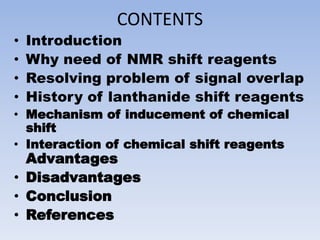
NMR Shift reagents
- 1. CONTENTS • Introduction • Why need of NMR shift reagents • Resolving problem of signal overlap • History of lanthanide shift reagents • Mechanism of inducement of chemical shift • Interaction of chemical shift reagents Advantages • Disadvantages • Conclusion • References
- 2. INTRODUCTION • Nuclear magnetic resonance spectroscopy (NMR) is the most powerful tool for organic and organometallic compound determination. • Structures can be determined using this technique. • In general NMR gives information about the number of magnetically distinct atoms of the specific nuclei under study, as well as information regarding the nature of the immediate environment surrounding each nuclei. • Because hydrogen and carbon are the major components of organic and organometallic compounds, proton (1H) NMR and carbon-13 (13C) NMR are the most useful nuclei to observe.
- 3. • Not all the protons experience resonance at the same frequency in a 1H NMR, so it is possible to differentiate between them. • This diversity is due to the existence of a different electronic environment around chemically different nuclei. • Under an external magnetic field (B0), the electrons in the valence shell are affected; they start to circulate generating a magnetic field, which is apposite to the applied magnetic field. This effect is called diamagnetic shielding or diamagnetic anisotropy
- 4. Why need of nmr shift reagents • The greater the electron density around one specific nucleus, the greater will be the induced field that opposes the applied field, and this will result in a different resonance frequency. • The identification of protons is simple, however, the NMR technique has a relatively low sensitivity of proton chemical shifts to changes in the chemical and stereochemical environment; as a consequence the resonance of chemically similar proton overlap .
- 5. Methods for resolving problem of signal overlap • use of higher frequency spectrometers • use of shift reagents - aromatic solvents • lanthanide complexes
- 6. History of lanthanide shift reagents • The first significant induced chemical shift using paramagnetic ions was reported in 1969 by Conrad Hinckley , where he used bispyridine adduct of tris(2,2,6,6-tetramethylhepta-3,5- dionato)europium(III) (Eu(tmhd)3), better known as Eu(dpm)3, where dpm is dipivaloyl- methanato. • Hinckley used Eu(tmhd)3 on the 1H NMR spectrum of cholesterol from 347 – 2 Hz. • Hinckley ‘s this new chemical method to improve the resolution of the NMR spectrum was the stepping- stone for the work of Jeremy Sanders and Dudley Williams .
- 7. Mechanism of inducement of chemical shift • Lanthanide atoms are Lewis acids, and because of that, they have the ability to cause chemical shift by the interaction with the basic sites in the molecules. • Lanthanide metals are especially effective over other metals because there is a significant delocalization of the unpaired f electrons onto the substrate as a consequence of unpaired electrons in the f shell of the lanthanide. • The lanthanide metal in the complexes interacts with the relatively basic lone pair of electrons of aldehydes, alcohols, ketones, amines and other functional groups within the molecule that have a relative basic lone pair of electrons, resulting in a NMR spectral simplification.
- 8. There are two possible mechanisms by which a shift can occur SHIFT BY CONTACT Transfer of electron spin density via covalent bond formation from the lanthanide metal ion to the associated nuclei. SHIFT BY PSUEDOCONTACT Magnetic effects of the unpaired electron magnetic moment causes the pseudocontact shift.
- 9. • Lanthanide complexes give shifts primarily by the pseudocontact mechanism. • Principal factor that influence the shift of a specific NMR peak is the distance between the metal ion and the proton; the shorter the distance, the greater the shift obtained • Direction of the shift depends on the lanthanide complex used. The complexes that produce a shift to a lower field (downfield) are the ones containing erbium, europium, thulium and ytterbium, while complexes with cerium, neodymium, holmium, praseodymium, samarium and terbium, shift resonances to higher field.
- 10. Interaction of chemical shift reagents:: Lanthanide complexes interact with a relatively basic pair of electrons ( an unshared pair ) which can coordinate with Eu+3. Typically, aldehydes, ketones, alcohols, thiols, ethers and amines all interact.
- 11. Example- The spectra of 1- hexanol: In the absence of shift reagent, the spectrum shown Only the triplet of the terminal methyl group the triplet of the methylene group next to the hydroxyl are resolved in the spectrum. The protons (aside from O-H) are found together in a broad, unresolved group. With the shift reagent added each of the methylene groups is clearly separated and is resolved into proper multiplet structure.
- 13. Advantages of using chemical shift reagents: •Gives spectra which are much easier to interpret. •No chemical manipulation of the sample is required with the use of shift reagents. •More easily obtained •Identifying enantiomeric mixtures in solution
- 14. disadvantage: • Shift reagents cause a small amount of line broadening At high shift reagent concentrations this problem becomes serious, but at most useful concentrations the amount of broadening is tolerable .
- 15. Conclusion Thus the chemical shift reagents and solvent induced shifts have their application in resolving the NMR spectra of complex structures by inducing shifts with respect to reference compound. Thus useful in interpretation of structures of complex organic compounds.
- 16. REFERENCES • Donald L.pavia, Gary M.Lampman, Georges S.Kriz , Introduction to spectroscopy , 3 rd edition, printed in the United States Of America, P.322-323, 109-110. • William Kemp, organic spectroscopy , 3 rd edition, printed by replica press ltd., India P.102-106, 131-133, 169-170. • C. C. Hinckley, J. Am. Chem. Soc., 1969, 91, 5160. • file:///F:/NMR%20reagents/introduction.xhtml •Edwin Becker, High Resolution NMR 3rd Edition
